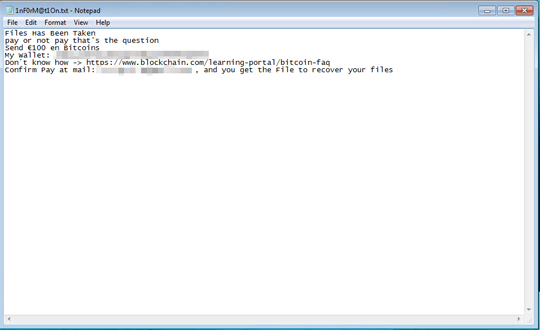Ransom.MSIL.CORVINA.A
Windows


Threat Type: Ransomware
Destructiveness: No
Encrypted: Yes
In the wild: Yes
OVERVIEW
This Ransomware arrives on a system as a file dropped by other malware or as a file downloaded unknowingly by users when visiting malicious sites.
It propagates via shared networks and drops copies of itself into available networks.
It encrypts files with specific file extensions. It drops files as ransom note.
TECHNICAL DETAILS
Arrival Details
This Ransomware arrives on a system as a file dropped by other malware or as a file downloaded unknowingly by users when visiting malicious sites.
Installation
This Ransomware drops the following copies of itself into the affected system:
- %AppDataLocal%\{filename}{file extension}
- filename can be any of the following:
- lsass
- csrss
- avp
- winlogon
- cacls
- cftmon
- GrooveMonitor
- scvhost
- inetinf
- spoolsv
- drwtsn
- MSServer
- rundll32
- dumprep
- Cmdlg
- msiexec
- ccEtvMgr
- wuauclt
- osk
- sihost
- file extension can be any of the following:
- .exe
- .src
(Note: %AppDataLocal% is the Local Application Data folder, which is usually C:\Documents and Settings\{user name}\Local Settings\Application Data on Windows 2000(32-bit), XP, and Server 2003(32-bit), or C:\Users\{user name}\AppData\Local on Windows Vista, 7, 8, 8.1, 2008(64-bit), 2012(64-bit) and 10(64-bit).)
It adds the following mutexes to ensure that only one of its copies runs at any one time:
- 2A2B2425586352797054307225242B2A
Autostart Technique
This Ransomware drops the following file(s) in the Windows User Startup folder to enable its automatic execution at every system startup:
- 0f81f97a-aaa6-4401-ae29-184e4f718009.lnk - dropped copy
- c4e69908-3cf5-42d4-b396-ca66b478f349.lnk - ransom note
Propagation
This Ransomware propagates via shared networks and drops copies of itself into available networks.
Information Theft
This Ransomware gathers the following data:
- Machine Name
- User Name
- Current date and time
- Hardware identification
- Randomly generated password
Stolen Information
This Ransomware sends the gathered information via HTTP POST to the following URL:
- https://n2019cov.{BLOCKED}hostapp.com/prueba.php
Other Details
This Ransomware does the following:
- Encrypts files in all the drives except files in protected folders
- Checks if:
- VM is present
- Operating system is Windows XP
- Debugger is Attached
- SbieDll.dll is loaded
- vboxhook.dll is in environment variable
- If any of the conditions above is met it starts the following process:
- cmd.exe /c ping0 -n 2 & del\{malware path and filename}
- ping 0 -n 2
- Drops copies of itself via shared network:
- %SystemRoot%\User\{string1}{string2}
- string1 can be any of the following:
- video
- foto
- amor
- sexo
- secreto
- string2 can be any of the following:
- .pif
- .com
- .scr
Ransomware Routine
This Ransomware encrypts files with the following extensions:
- .doc
- .docx
- .xslx
- .xls
- .jpg
- .bmp
- .ppt
- .pptx
- .txt
- .gif
- .jpeg
- .png
- .psd
- .dwg
It appends the following extension to the file name of the encrypted files:
- .P4WN3D
It drops the following file(s) as ransom note:
- %AppDataLocal%\1nF0rM@t1On.txt

SOLUTION
Step 1
Trend Micro Predictive Machine Learning detects and blocks malware at the first sign of its existence, before it executes on your system. When enabled, your Trend Micro product detects this malware under the following machine learning name:
- Troj.Win32.TRX.XXPE50FFF035
Step 2
Before doing any scans, Windows 7, Windows 8, Windows 8.1, and Windows 10 users must disable System Restore to allow full scanning of their computers.
Step 3
Note that not all files, folders, and registry keys and entries are installed on your computer during this malware's/spyware's/grayware's execution. This may be due to incomplete installation or other operating system conditions. If you do not find the same files/folders/registry information, please proceed to the next step.
Step 4
Restart in Safe Mode
Step 5
Search and delete this file
- %AppDataLocal%\1nF0rM@t1On.txt
- %User Startup%\0f81f97a-aaa6-4401-ae29-184e4f718009.lnk
- %User Startup%\c4e69908-3cf5-42d4-b396-ca66b478f349.lnk
Step 6
Restart in normal mode and scan your computer with your Trend Micro product for files detected as Ransom.MSIL.CORVINA.A. If the detected files have already been cleaned, deleted, or quarantined by your Trend Micro product, no further step is required. You may opt to simply delete the quarantined files. Please check this Knowledge Base page for more information.
Step 7
Scan your computer with your Trend Micro product to delete files detected as Ransom.MSIL.CORVINA.A. If the detected files have already been cleaned, deleted, or quarantined by your Trend Micro product, no further step is required. You may opt to simply delete the quarantined files. Please check the following Trend Micro Support pages for more information:
Step 8
Restore encrypted files from backup.
Did this description help? Tell us how we did.


